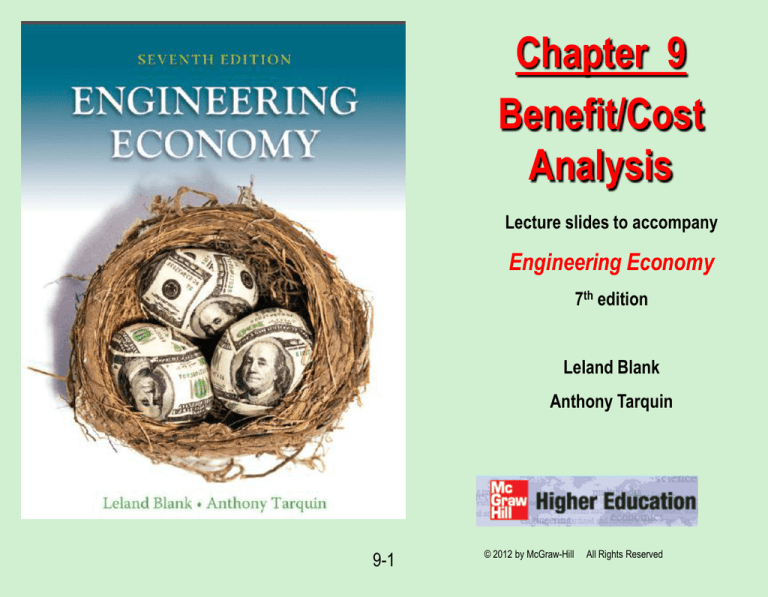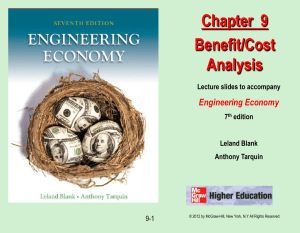
Chapter 9
Benefit/Cost
Analysis
Lecture slides to accompany
Engineering Economy
7th edition
Leland Blank
Anthony Tarquin
9-1
© 2012 by McGraw-Hill
All Rights Reserved
Differences: Public vs. Private Projects
Characteristic
Public
Size of Investment
Large
Life
Annual CF
Funding
Interest rate
Selection criteria
Longer (30 – 50+ years)
No profit
Private
Small, medium, large
Shorter (2 – 25 years)
Profit-driven
Taxes, fees, bonds, etc. Stocks, bonds, loans, etc.
Lower
Multiple criteria
Environment of evaluation Politically inclined
9-2
Higher
Primarily ROR
Economic
Types of Contracts
Contractors does not share project risk
Fixed price - lump-sum payment
Cost reimbursable - Cost plus, as negotiated
Contractor shares in project risk
Public-private partnerships (PPP), such as:
Design-build projects - Contractor responsible from
design stage to operations stage
Design-build-operate-maintain-finance (DBOMF)
projects - Turnkey project with contractor managing
financing (manage cash flow); government obtains
funding for project
9-3
Cash Flow Classifications and B/C Relations
Must identify each cash flow as either benefit, disbenefit, or cost
Benefit (B) -- Advantages to the public
Disbenefit (D) -- Disadvantages to the public
Cost (C) -- Expenditures by the government
Note: Savings to government are subtracted from costs
Conventional B/C ratio = (B–D) / C
Modified B/C ratio = [(B–D) – C] / Initial Investment
Profitability Index = NCF / Initial Investment
Note 1: All terms must be expressed in same units, i.e., PW, AW, or FW
Note 2: Do not use minus sign ahead of costs
9-4
Decision Guidelines for B/C and PI
Benefit/cost analysis
If B/C ≥ 1.0, project is economically justified at
discount rate applied
If B/C < 1.0, project is not economically acceptable
Profitability index analysis of
revenue projects
If PI ≥ 1.0, project is economically justified at
discount rate applied
If PI < 1.0, project is not economically acceptable
9-5
B/C Analysis – Single Project
Conventional B/C ratio =
B-D
C
Modified B/C ratio = B – D – M&O
C
PW of NCFt
PI =
PW of initial investment
If B/C ≥ 1.0,
accept project;
otherwise, reject
Denominator is
initial investment
If PI ≥ 1.0, accept project; otherwise, reject.
9-6
Example: B/C Analysis – Single Project
A flood control project will have a first cost of $1.4 million with an annual
maintenance cost of $40,000 and a 10 year life. Reduced flood damage is
expected to amount to $175,000 per year. Lost income to farmers is estimated
to be $25,000 per year. At an interest rate of 6% per year, should the
project be undertaken?
Solution: Express all values in AW terms and find B/C ratio
B = $175,000
D = $25,000
C = 1,400,000(A/P,6%,10) + $40,000 = $230,218
B/C = (175,000 – 25,000)/230,218
Do not build project
= 0.65 < 1.0
9-7
Defender, Challenger and Do Nothing Alternatives
When selecting from two or more ME alternatives, there is a:
Defender – in-place system or currently selected alternative
Challenger – Alternative challenging the defender
Do-nothing option – Status quo system
General approach for incremental B/C analysis of two ME alternatives:
Lower total cost alternative is first compared to Do-nothing (DN)
If B/C for the lower cost alternative is < 1.0, the DN option is compared to
∆B/C of the higher-cost alternative
If both alternatives lose out to DN option, DN prevails, unless overriding
needs requires selection of one of the alternatives
9-8
Alternative Selection Using Incremental B/C
Analysis – Two or More ME Alternatives
Procedure similar to ROR analysis for multiple alternatives
(1)
(2)
(3)
(4)
(5)
(6)
(7)
Determine equivalent total cost for each alternative
Order alternatives by increasing total cost
Identify B and D for each alternative, if given, or go to step 5
Calculate B/C for each alternative and eliminate all with B/C < 1.0
Determine incremental costs and benefits for first two alternatives
Calculate ∆B/C; if >1.0, higher cost alternative becomes defender
Repeat steps 5 and 6 until only one alternative remains
9-9
Example: Incremental B/C Analysis
Compare two alternatives using i = 10% and B/C ratio
Alternative
X
Y
First cost, $
M&O costs, $/year
Benefits, $/year
Disbenefits, $/year
Life, years
320,000
45,000
110,000
20,000
10
540,000
35,000
150,000
45,000
20
Solution: First, calculate equivalent total cost
AW of costsX = 320,000(A/P,10%,10) + 45,000 = $97,080
AW of costsY = 540,000(A/P,10%,20) + 35,000 = $98,428
Order of analysis is X, then Y
X vs. DN: (B-D)/C = (110,000 – 20,000) / 97,080 = 0.93 Eliminate X
Y vs. DN:
(150,000 – 45,000) / 98,428 = 1.07 Eliminate DN
9-10
Example: ∆B/C Analysis; Selection Required
Must select one of two alternatives using i = 10% and ∆B/C ratio
Alternative
X
Y
First cost, $
M&O costs, $/year
Benefits, $/year
Disbenefits, $/year
Life, years
320,000
45,000
110,000
20,000
10
540,000
35,000
150,000
45,000
20
Solution: Must select X or Y; DN not an option, compare Y to X
AW of costsX = $97,080
AW of costsY = $98,428
Incremental values: ∆B = 150,000 – 110,000 = $40,000
∆D = 45,000 – 20,000 = $25,000
∆C = 98,428 – 97,080 = $1,348
Y vs. X: (∆B - ∆D) / ∆C = (40,000 – 25,000) / 1,348 = 11.1 Eliminate X
9-11
B/C Analysis of Independent Projects
Independent projects comparison does not require
incremental analysis
Compare each alternative’s overall B/C with DN option
+ No budget limit: Accept all alternatives with B/C ≥ 1.0
+ Budget limit specified: capital budgeting problem; selection
follows different procedure (discussed in chapter 12)
9-12
Cost Effectiveness Analysis
Service sector projects primarily involve intangibles, not
physical facilities; examples include health care, security
programs, credit card services, etc.
Cost-effectiveness analysis (CEA) combines monetary cost
estimates with non-monetary benefit estimates to calculate the
Cost-effectiveness ratio (CER)
Equivalent total costs
CER = Total effectiveness measure = C/E
9-13
CER Analysis for Independent Projects
Procedure is as follows:
(1) Determine equivalent total cost C, total effectiveness measure E and CER
(2) Order projects by smallest to largest CER
(3) Determine cumulative cost of projects and compare to budget limit b
(4) Fund all projects such that b is not exceeded
Example: The effectiveness measure E is the number of graduates from adult
training programs. For the CERs shown, determine which independent
programs should be selected; b = $500,000.
Program
A
B
C
D
CER, $/graduate
1203
752
2010
1830
Program Cost, $
305,000
98,000
126,000
365,000
9-14
Example: CER for Independent Projects
First, rank programs according to increasing CER:
Program
B
A
D
C
CER, $/graduate
Cumulative
Program Cost, $
Cost, $
752
1203
1830
2010
98,000
305,000
365,000
126,000
98,000
403,000
768,000
894,000
Next, select programs until budget is not exceeded
Select programs B and A at total cost of $403,000
Note: To expend the entire $500,000, accept as many additional
individuals as possible from D at the per-student rate
9-15
CER Analysis for Mutually Exclusive Projects
Procedure is as follows
(1)
(2)
(3)
Order alternatives smallest to largest by effectiveness measure E
Calculate CER for first alternative (defender) and compare to DN option
Calculate incremental cost (∆C), effectiveness (∆E), and incremental measure
∆C/E for challenger (next higher E measure)
(4) If ∆C/Echallenger < C/Edefender challenger becomes defender (dominance);
otherwise, no dominance is present and both alternatives are retained
(5) Dominance present: Eliminate defender and compare next alternative
to new defender per steps (3) and (4).
Dominance not present: Current challenger becomes new defender against
next challenger, but old defender remains viable
(6) Continue steps (3) through (5) until only 1 alternative remains or only
non-dominated alternatives remain
(7) Apply budget limit or other criteria to determine which of remaining
non-dominated alternatives can be funded
9-16
Example: CER for ME Service Projects
The effectiveness measure E is wins per person. From the cost
and effectiveness values shown, determine which alternative to
select.
Program
A
B
C
Cost (C)
$/person
2200
1400
6860
Effectiveness (E)
wins/person
4
2
7
9-17
CER
$/win
550
700
980
Example: CER for ME Service Projects
Solution:
Order programs according to increasing effectiveness measure E
Program
Cost (C)
$/person
Effectiveness (E)
wins/person
B
A
C
1,400
2,200
6,860
2
4
7
B vs. DN: C/EB = 1400/2 = 700
A vs. B: ∆C/E = (2200 – 1400)/(4 – 2) = 400
C vs. A: ∆C/E = (6860 – 2200)/(7 – 4) = 1553
CER
$/win
700
550
980
Dominance; eliminate B
No dominance; retain C
Must use other criteria to select either A or C
9-18
Ethical Considerations
Engineers are routinely involved in two areas
where ethics may be compromised:
Public policy making – Development of strategy, e.g.,
water system management (supply/demand strategy;
ground vs. surface sources)
Public planning - Development of projects, e.g., water
operations (distribution, rates, sales to outlying areas)
Engineers must maintain integrity and impartiality and
always adhere to Code of Ethics
9-19
Summary of Important Points
B/C method used in public sector project evaluation
Can use PW, AW, or FW for incremental B/C analysis, but must
be consistent with units for B,C, and D estimates
For multiple mutually exclusive alternatives, compare two at a time
and eliminate alternatives until only one remains
For independent alternatives with no budget limit, compare each against
DN and select all alternatives that have B/C ≥ 1.0
CEA analysis for service sector projects combines cost and
nonmonetary measures
Ethical dilemmas are especially prevalent in public sector projects
9-20







